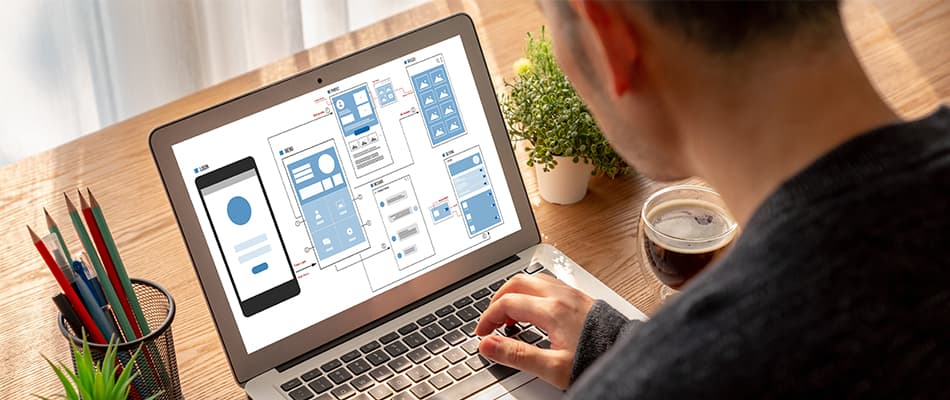What is UI/UX Design? Understanding the Basics and Importance
UI and UX design are important for creating digital experiences that are easy to use and enjoyable. So, what is UI/UX design? It combines two essential parts: User Interface (UI) design, which focuses on how things look, such as layouts, colours, and fonts, and User Experience (UX) design, which ensures the product works well and meets the user’s needs. They influence how people interact with websites, apps, and other digital tools. UI makes a design visually appealing, while UX ensures it is simple to navigate and functional. By working together, they create digital products that people find attractive and easy to use.
This article explains their meaning, differences, and why they are so important in the graphic design industry.
What is the Difference Between UX and UI Design?
Understanding the roles of User Interface and User Experience design is essential for creating impactful and user-friendly digital products. But what is UI/UX design? Users find designing visually appealing interfaces and crafting meaningful experiences intuitive and enjoyable. UI focuses on the visual aspects, such as colours, typography, and layouts, while UX ensures smooth direction, accessibility, and overall satisfaction. Though closely related, these two disciplines serve distinct purposes.
Let’s understand the difference between UX and UI Design through this table:
|
Aspect |
User Interface (UI) |
User Experience (UX) |
|
What It Focuses On |
It focuses on the product’s appearance, including colours, fonts, and layouts. |
It focuses on how the product works and how easily users can interact with it. |
|
Purpose |
It makes the product visually appealing and consistent. |
It makes the product simple, user-friendly, and enjoyable to use. |
|
Main Tasks |
It involves designing layout buttons and choosing colours and fonts. |
It involves researching user needs, creating wireframes, and testing how the product works. |
|
Tools Used |
It uses tools like Adobe XD, Figma, and Sketch for visual design. |
It uses Axure, Balsamiq, and testing platforms to improve usability. |
|
End Results |
It creates an attractive design that catches attention. |
It ensures a smooth experience that keeps users happy and engaged. |
What is UX Design?
User Experience (UX) design focuses on making products or services easy and enjoyable. It ensures users can complete tasks and meet their needs without difficulty. To understand what is UI/UX design, think of UX as the foundation that shapes how a product works and feels. UX design involves simple steps like understanding user needs through research, planning layouts with wireframes, and testing designs to improve them. These steps make sure the product is user-friendly and easy to use.
The main goal of UX design is to create digital products, such as websites or apps, that are simple and satisfying to use. It helps users have a smooth experience, builds trust, and makes them happy with the product.
Key Elements of UX Design
Creating a strong user experience starts with understanding the essential elements that shape it. These components are necessary to ensure digital products are intuitive, functional, and enjoyable. If you want to understand what is UI/UX design, it’s important to explore each element individually and how they contribute to meeting user needs and creating meaningful interactions. Focusing on aspects like usability, visual appeal, and user research helps designers build products that are not only efficient but also leave a lasting positive impression.
Listed below are the core elements of UX Design:
- User Research – This involves learning about users’ needs, preferences, and behaviours to create designs that solve their problems and meet their expectations.
- Information Architecture – It focuses on organising content clearly and logically, making it easy for users to find what they need.
- Wireframing and Prototyping – Wireframes are basic layouts, and prototypes are sample designs that help test how a product looks and works before final development.
- Usability Testing – This step involves testing the product with real users to find and fix issues, ensuring it is simple and effective.
- Visual Design – Visual design focuses on how the product looks, using colours, fonts, and images to make it appealing and functional.
- Interaction Design – It adds interactive features like buttons or animations to make the product engaging and easy for users to direct.
- Consistency – Consistency in design ensures that elements like colours, fonts, and layouts remain uniform throughout the product, providing a smooth and cohesive user experience.
What is UI Design?
UI design is about making digital products easy to use and visually appealing. When exploring what is UI/UX design, you’ll find that it combines the look and feel of a product, focusing on elements like buttons, menus, colours, fonts, and layouts. UI design ensures the product is easy to use and looks good. It helps users quickly understand how to use a website or app without confusion. A good UI design improves the user’s experience by making interactions smooth and simple. It also builds trust with users, encouraging them to keep using the product. In short, UI design is important for creating functional and visually attractive products.
Read How to Become a UI Designer here
Key Elements of UI Design
User interface (UI) design is about making digital products simple and enjoyable. Understanding what is UI/UX design helps to see how UI elements improve how people interact with a website or app. These elements are designed to make moving through the site clear, layouts attractive, and actions easy. By focusing on organisation and responsiveness, UI design ensures users can complete their tasks smoothly and have a positive experience.
Let us look at the core elements of UI Design below:
- Visual Appeal – Using colours, fonts, and images to make the design look attractive and welcoming. For example, soft colours and simple fonts can make a website feel professional and easy to read.
- Interactive Features – Create buttons, menus, and other clickable parts that users can easily interact with. For instance, a clear ‘Add to Cart’ button makes online shopping simple and convenient.
- Organised Content – Arranging information in a way that’s easy to understand and find. For example, a food app might group items into sections like ‘Fast Food’ or ‘Healthy Options.’
- Responsive Design – Ensure the design works well on all devices, such as a website that automatically adjusts to look good on a mobile phone or tablet.
Importance of UI and UX Design
UI/UX design is important in how users interact with digital products. Understanding what is UI/UX design shows us how essential it is to create enjoyable and easy experiences. When the user interface is well-designed and the user experience is smooth, it leads to better engagement, increased satisfaction, and higher retention rates. A good UI/UX design ensures that users can easily direct a product while having a positive experience that encourages them to return.
Let us look at the main reasons why UI and UX Design are important:
- Improves User Satisfaction – A well-designed interface helps users complete tasks easily, making their experience enjoyable and stress-free.
- Builds Brand Trust – Clear and easy-to-use designs create a sense of professionalism and make users trust the brand more.
- Enhances Accessibility – UI/UX design ensures that websites and apps are easy for everyone to use, regardless of their device or ability.
- Boosts User Engagement – Attractive and simple designs keep users interested, encouraging them to stay on the platform longer.
- Increases Conversion Rates – Easy navigation and clear actions help turn visitors into customers or subscribers.
- Supports Business Growth – A good user experience leads to positive reviews, which help attract more users and drive growth.
- Reduces Costs – Well-planned design reduces mistakes and saves money by avoiding costly redesigns later.
Why Choose Digital Regenesys?
If you want to become a skilled UI/UX designer, Digital Regenesys offers an excellent opportunity with its UI/UX and Graphic Design Course with GenAI. This course will teach you what is UI/UX Design and how to create attractive, user-friendly designs by combining User Interface (UI) and User Experience (UX) principles. Additionally, you’ll learn to incorporate the latest Generative AI (Gen AI) techniques, equipping you with the tools and skills needed to succeed in the fast-evolving design industry.
Here are the advantages of enroling in this course at Digital Regenesys:
- Expert Guidance – Learn from experienced mentors who provide practical insights and support throughout your learning journey.
- Hands-On Learning – Gain real-world experience by working on projects and building a portfolio that showcases your skills.
- Industry-Standard Tools – Get hands-on experience with leading design tools like Canva, Adobe Creative Cloud, Figma, and no-code platforms like WordPress and Webflow.
- Detailed Curriculum – Master UI/UX design and essential coding skills (HTML, CSS, JavaScript) to create websites and mobile apps.
- Globally Recognised Certificates – Earn 12 certifications that enhance your career and make you more competitive in the job market.
Thus, understanding what is UI/UX design is important for anyone who wants to create user-friendly, engaging digital experiences. Combining UI and UX design ensures that websites and apps are visually appealing, easy to use, and enjoyable. If you want to learn how to design great user interfaces and experiences, enroling in the UI/UX and Graphic Design Course with GenAI at Digital Regenesys is the perfect step. Start your journey today and develop the skills needed for a successful career in design.
What is UI/UX Design? – FAQS
How does UX/UI Design impact user satisfaction?
UI/UX design combines User Interface (UI) and User Experience (UX), with UI focusing on visual elements and UX ensuring ease of use. The UI UX meaning is how both the look and functionality work together to create a smooth, engaging experience, leading to higher user satisfaction and encouraging repeat use.
What is the difference between UX and UI design?
UX design focuses on improving how easy and enjoyable a product is to use, while UI design is all about its visual elements, such as the layout, colours, and buttons, that make the product look good and easy to navigate.
What is UX design?
UX design is creating products that are simple to use and meet the user’s needs. It’s all about designing a seamless experience that ensures users feel comfortable and satisfied while interacting with the product.
What is UI design?
UI design focuses on the look of a product, including elements like buttons, fonts, and colour schemes. It ensures that everything is visually appealing and easy to interact with, creating an engaging user experience.
What is the importance of UX UI design?
Through this article, we have understood what is UI/UX Design, but it is also important to understand its significance. A well-designed product is visually appealing and easy to use, making the overall experience enjoyable and encouraging users to engage more with the product.













